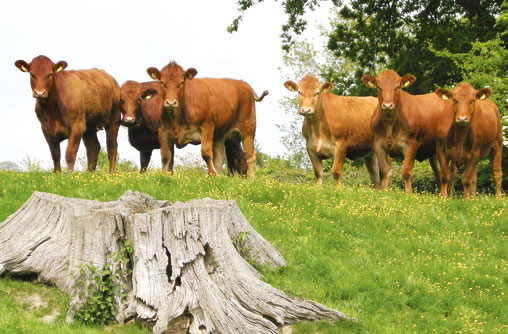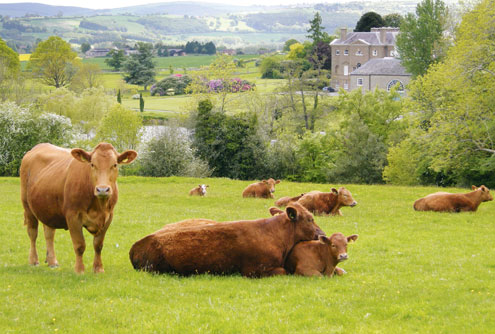Don’t underestimate herd performance on the bottom line

For most beef producers the end-product is a key benchmark for success. But in reality, it’s not the best indicator of profitability.
This was exactly the wake-up call James Evans, from Partridge Farm, in Linley, Shropshire, needed to reassess his business.
After visiting two Stabiliser herds on a tour to Cumbria in 2007 he realised his beef enterprise wasn’t making any money.
“On the face of it, it looked like we were doing a good job, but that was only half the story. I had been looking at it from the wrong angle.
“I realised how out of touch I had become, I had lost sight of the most important thing – profitability,” James says.
While James admits he often topped the market with his cattle, the end-product had come at too great a cost.
“Losses at birth were far too high and the number of barren cows meant that the figures didn’t stack up.
“I was focusing on the end-product and was missing everything else.
“Too many people are focusing on getting an animal at the end which wins a rosette. But are they actually making any money? You have to be true to yourself in order to be true to your business,” he adds.
Five years on and James, who farms in partnership with his older brother Rob and father John, has replaced most of his Limousin cross Holstein herd with 220 purebred Stabilisers. It’s been a decision that wasn’t entered into light-heartedly, but it has paid dividends.
Herd performance has improved dramatically and as a result, profits have increased two-fold.
The herd is now divided into two in order to ease the pressure on labour. One hundred autumn calvers are kept at James’s 307ha home farm, Walcot Farm, in Lydbury North.
A further 160 spring-calving cows are kept at Partridge Farm – a 518ha farm run on a contract farming agreement.
Approximately 323ha of land is arable, which is managed by his brother, while James manages the livestock enterprise, including the suckler herd and 1100 breeding ewes.
Bulling and calving
A key driver for profitability has been calving the heifers at two years, using artificial insemination to introduce new blood lines into the herd.
“Calving heifers at two years helps produce a more economic beef system, because essentially, more calves are being produced,” James explains.
Calving intervals are kept exceptionally tight, by rigorously semen testing stock bulls to ensure fertility is high and by only keeping the stock bull in for nine weeks.
“Many cows go to bull in the first cycle, so they all calve really quickly and have plenty of time to gain condition to go back to the bull,” James says.
So far 81% of the spring herd has already calved in the first three weeks of calving.
“It makes life a whole lot easier. You’ve got to check on cows whether you’ve got one left to calve or 100.
“It’s not for everyone, some people wouldn’t want to calve as quickly, but I like to get it over and done and get on with other things.”
Since switching to Stabilisers, barren rates have dropped from 10-15% to 3.7%.
In addition, all Stabilisers are performance-recorded, which has led to a vast improvement in calving ease.
Part of the reason why calving ease has improved is that the gestation period for composite breeds likes Stabilisers are shorter at 283 days, compared with 290-295 days for some continental breeds.
“We very rarely assist any calving now and we hardly ever have to suckle a calf.
“They are good mothers and because the calves are low birth weight, they are born without any stress and they’re up and suckling within minutes,” says James.

Rations
Rearing rates have also improved and a total of 88 calves have already been weaned off his 92-cow autumn herd.
Any cattle that aren’t kept for replacements are sold as store cattle. These are usually weaned off their mothers at around six months of age, averaging 330kg.
They are then brought inside and fed a ration of grass silage, wheat straw, barley and minerals to achieve an average daily weight gain of 1.4kg, before being sold at 10 months, having grown to average 422kg.
“Where I gain massively is I have now got at least 10 more cattle to sell than I used to have, because I’m not getting the losses I used to get. That’s what makes the bottom line so much better and that’s what so many people lose focus on,” he explains.
Feed costs are playing an increasingly important role in maximising profit margins.
Although the arable farm means that home-grown forage can be utilised to its full effect, everything is costed in and out, which ensures that each enterprise is making a profit individually.
“I have to prove to the rest of the family and my business consultant that I can buy barley off the arable enterprise and make money on it over and above what they can sell it for, so it’s vital everything is costed at its real value.”
The spring-calving cows are fed on a winter TMR mix of 16kg of grass silage and 4kg of wheat straw, which is fed through a mixer wagon to minimise wastage. Coupled with 100g of mineral, this weighs in at a cost of 80p a cow a day.
“Although it’s a ration for maintenance, the cows actually gain condition on that,” James explains.
Monitoring growth rates is a crucial part of the system and all young stock are weighed at birth and thereafter at 100, 200 and 400 days in order to determine which animals have the best traits for breeding. This also enables James to balance costs precisely and adjust feed intake accordingly.
“Females have to weigh 400kg at 14 months, because if they don’t, it means they haven’t grown as well and we’d be breeding from sub-standard stock, so their calves wouldn’t grow as well either,” he says.
All breeding stock is also scanned to measure muscle depth and fat depth.
“This allows me to breed cattle which have far better carcass traits, rather than previously judging cattle by eye, and helps dispel the myth that cattle with a big back end kill out better.”
Breeding
Breeding criteria are strict to make sure herd performance is consistently improved.
Bulls are selected on their top 5% MPV (Maternal Production Values) figures. This encompasses a range of values such as calving ease, gestation length, growth rate and 200-day milk.
“One of the main targets is to produce a low birth weight calf that has a high growth rate, known as “curve benders”.
“The chances are the animal which grows the fastest is usually the heaviest calf at birth, which can lead to calving problems. This is why no calves born at 45kg and over are kept back for breeding, because we are trying to keep everything in balance in order to maximise efficiency.”
According to James, it is this attention to detail when selecting bulls on their MPV figures that has led to a dramatic increase in productivity.
“It ensures you’re not selecting for extremes in any one trait. It’s all about keeping the cow in perfect balance.”
Performance and profit
For James, the future lies in running a completely efficient beef system.
One of the main performance targets he is trying to improve is a single efficiency figure for his herd – kg of calf weaned for each kg of cow mated. This year the autumn calving herd has produced the highest figure to date, at 54.4% (see table).
“This figure shows that on average the cows are weaning over half their body weight as a weaned calf and the higher this figure, the more efficient the cow,” James explains.
“This figure is probably one of the most important I use and believe this should be a benchmarking standard throughout all suckler cow enterprises, as it allows equal comparisons, regardless of breed or land type.”
James says one of the most important factors is that cows are weighed before bulling, rather than at weaning.
“Weighing at weaning can lead to inflated figures, as it only shows cows with calves at foot, as opposed to every cow that was put to the bull,” he adds.
It’s this focused approach to performance that has led to significant improvements in profit margins.
Profit for each cow, excluding labour and variable costs, is now averaging £304.72.
One of the biggest influences has been a reduction in labour costs.
“They are a really docile breed, which means they’re a lot easier to handle. Probably the only downside to the breed is moving them – you can’t move them in a hurry,” James says.
But ever the perfectionist, James is not content just yet.
In the next five years he hopes to be producing a calf off every cow bulled through rigorous breeding selection and he would like EBV values to be within the top 10% for the breed.
The proof will be in his next balance sheet.
| Comparison of physical performance | |||
|---|---|---|---|
| Evans autumn calving herd | Evans spring calving herd | EBLEX top third | |
| Barren cows per 100 | 2.2 | 3.8 | 6.3 |
| Calves born alive per 100 | 97.8 | 96.2 | 88.6 |
| Calves died per 100 | 3 | 4 | 1.7 |
| Calves reared per 100 | 95 | 93 | 87 |
| Calving period (weeks) | 9 | 10 | 19 |
| Calving Index (days) | 362 | 355 | – |
| % calved in first three weeks | 75 | 80 | – |
| The EBLEX figures have been selected from the 2011 business pointers for lowland suckler herd | |||
